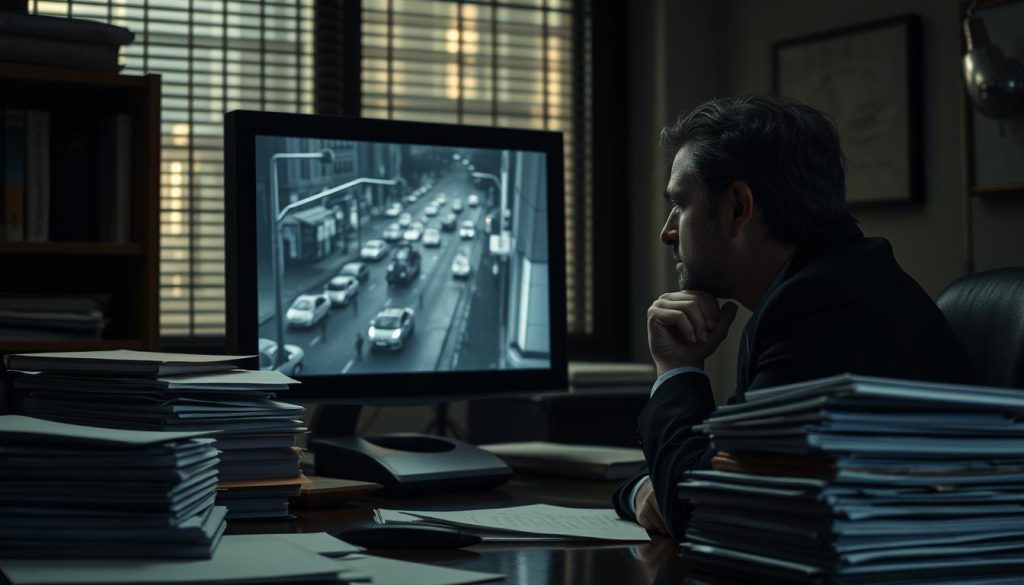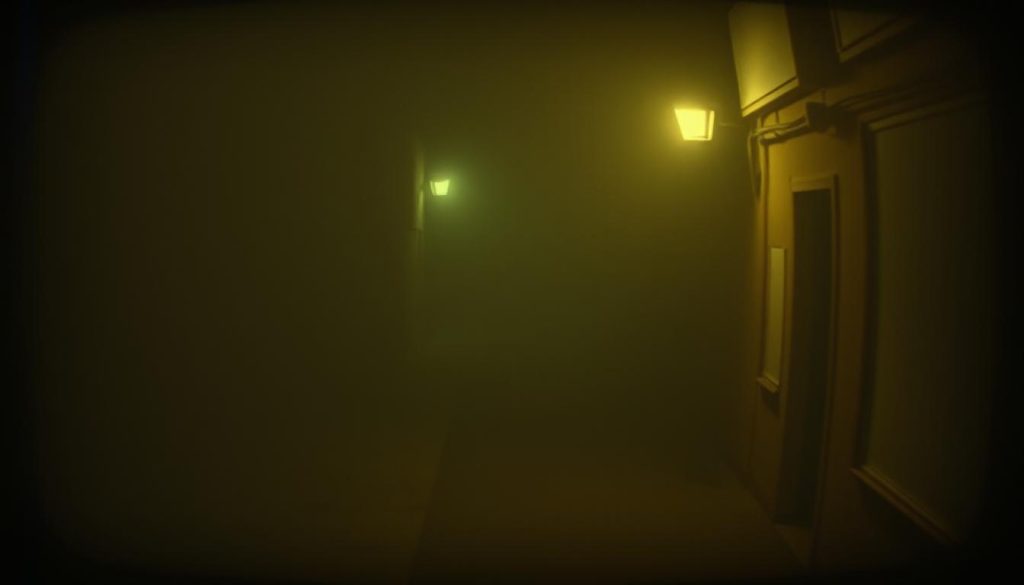In today’s world, managing old security camera footage is key for both personal and business use. With more security cameras around, it’s important to know how CCTV footage is handled. Things like storage, camera types, and laws affect how long video stays.
Knowing about video retention policies helps make better choices about keeping important footage. For more on keeping footage for a long time, check out this resource.
Key Takeaways
- Understanding old security camera footage is key for good surveillance management.
- CCTV footage management involves many factors that affect how long footage lasts.
- Storage methods and camera types impact how long footage is kept.
- Legal rules are also important in video retention policies.
- Knowing about retention policies can improve security in businesses.
Understanding Security Camera Storage Systems
Effective footage management starts with knowing how security camera storage systems work. These systems handle how video data is recorded, stored, and accessed. They use different types of storage devices for various needs.
Types of Storage Devices
The choice of storage devices is key in security camera systems. Here are some common ones:
- Digital Video Recorders (DVRs): These devices process data right where they are. They work well with analog cameras.
- Network Video Recorders (NVRs): NVRs handle video from IP cameras. They process info at the camera level. This is great for setups with many high-definition cameras.
- Surveillance Hard Drives: Made for constant video recording, these drives are more reliable than regular computer hard drives.
- Cloud Storage: This option stores data online. It lets you access your video from anywhere with internet, making it safer.
- SD Cards: Used in standalone cameras, these cards are a portable way to store video. But they have limits on how much you can store and for how long.
How Recorders Work: DVR vs NVR
It’s important to know how DVR and NVR systems work to choose the right one for you. DVRs take footage from analog cameras, compress it, and save it on a hard drive. It’s simple but has its limits.
NVRs, on the other hand, work with IP cameras. They process video data right at the camera. This means NVRs can handle lots of high-quality footage at once. They’re great for big security camera setups.
Factors Influencing Footage Retention Time
Many things can change how long security camera footage is kept. Knowing these can help make a security system work better. Important parts include storage space and how the cameras record, both key to how long footage stays available.
Storage Capacity Variations
The amount of storage a security system has greatly affects how long footage is kept. Storage can vary by:
- Number of cameras in use
- Types of storage devices employed
- Quality of the recording hardware
More storage means you can keep footage longer. Systems with less storage might have to overwrite footage often, making it shorter.
Recording Settings and Frequencies
How you set up recording is key to managing video data. Different settings can change how long footage is kept. For example, recording all the time uses more storage than recording only when motion is detected. Other key factors include:
- Video resolution
- Frame rates
Higher resolutions and frame rates make files bigger, using more storage. It’s important to adjust these settings to fit your needs.
How Long Do Security Cameras Keep Footage?
Understanding how long security cameras keep footage is key to any security plan. Companies need to know the usual time frames to handle their footage well. Most systems keep video for 30 to 90 days. But, some things can change these times a lot.
Typical Retention Periods
For regular watching, keeping footage for 30 to 90 days is a good middle ground. It balances saving space and having video for investigations. The time can change based on why you’re watching and how much space you have.
For example, homes might keep footage for less time. But, businesses often keep it longer because they have more activity.
High-Security Environments and Storage Requirements
In places that need extra security, like banks or airports, keeping footage longer is common. These places often keep video for over six months. Laws or company rules might make them keep footage longer. This ensures they have evidence if something bad happens.
What happens to old security camera footage?
As time goes by, security camera footage can no longer be stored well. It’s key to know about the automatic deletion and overwriting process for old footage management. Most security camera systems have limited storage. This can lead to footage being deleted.
Automatic Deletion and Overwriting Process
Most surveillance systems manage old footage in a simple way. They delete or overwrite recordings when they reach a certain age. This keeps recording smooth but needs careful handling to avoid losing important data.
- It’s vital to schedule regular backups to keep important footage safe before it gets deleted.
- Having a good plan for managing old footage means checking storage often to make sure there’s enough room.
- Knowing how the overwriting process works helps plan keeping important recordings.
In short, understanding how footage gets deleted and the overwriting process is very important. It’s key for anyone using security cameras for watching over places, like high-security areas.
Cloud Storage vs. Local Storage
Choosing between cloud storage and local storage for security camera footage is key. Each has its own benefits and drawbacks that affect how you manage and access your data.
Advantages of Cloud Solutions
Cloud storage has many perks for managing security footage. It’s flexible, letting you view your data from anywhere with internet. Cloud services also grow easily, without needing new hardware.
This is great for businesses that need more storage as they grow. Clouds also have automatic backups, keeping your footage safe from loss.
Risks Associated with Local Storage
Local storage seems good because it’s right there, but it has big risks. Data can get damaged, and you might lose important footage. Users can also accidentally delete files, which is bad.
Local devices can break down, stopping you from recording or getting footage. So, comparing cloud and local storage shows cloud is safer and more reliable.
Best Practices for Retaining Important Footage
Keeping security footage safe is key for strong surveillance. It’s important to have good backup plans. This helps protect important recordings and boosts security readiness.
Organizations gain a lot from these steps. They help keep important info safe and available.
Establishing Backup Protocols
Creating solid backup plans is a smart move. It means saving key data on external drives or in the cloud. This way, you avoid losing important footage due to mistakes or hardware failures.
Setting up regular backups is also smart. It makes sure you always have the latest recordings safe.
Regularly Monitoring Storage Capacity
Watching your storage space is another must. It helps you know when to clear out old recordings. This smart management of space is essential.
Changing your recording settings based on needs can also help. It makes your monitoring more effective.
Storage Solutions Based on Camera Types
Choosing the right storage for security cameras is key. Different systems need different things based on their use. Knowing the best storage for home and commercial cameras helps manage data well.
Options for Home Security Systems
Home security cameras usually need simple storage. Many use SD cards or basic hard drives. This makes setting them up and keeping them running easy for homeowners.
These options give enough room for daily footage. It’s easy to check recordings when needed. You can add more storage if you want to keep more or better-quality videos.
Commercial Security Cameras and Their Requirements
Commercial cameras, on the other hand, need stronger storage. Network-Attached Storage (NAS) devices are often used in businesses. They can handle lots of data.
Cloud storage is also big for businesses. It offers flexibility and a backup off-site. This is key for keeping operations running smoothly. Good storage for businesses meets their big surveillance needs and follows data rules.
Legal Implications of Footage Retention
It’s key for businesses in Singapore to know the legal side of keeping security camera footage. They need to understand data storage laws. These laws say how long recordings must stay. Following them helps avoid legal trouble and keeps businesses in line with standards.

In Singapore, companies must stick to certain data storage rules. These rules might ask them to keep footage for a set time. The length of time depends on the footage’s type and use, like for legal reasons. Businesses that know these laws well can handle legal rules better.
Data Storage Laws in Singapore
Singapore’s data storage laws aim to protect personal info and privacy. Companies must follow these laws closely. Not following them can cause big fines and harm to their reputation. Knowing these laws helps businesses make strong rules for keeping footage.
Best Practices for Compliance
Good practices for following the law also reduce data misuse risks. Here are some tips:
- Check and update your footage keeping rules often.
- Use strict rules to see who can watch or manage the footage.
- Use automatic systems to delete or save footage as the laws say.
By following these tips, businesses not only follow the law but also improve their data handling. This way, they can meet legal needs and protect their interests well.
What You Can Do If You Need to Retain Footage Longer
In today’s world, keeping footage longer is key for many. Good storage solutions help keep important clips safe for longer. Here are some ways to manage your footage better:
- Upgrade your hardware: Get high-capacity hard drives or solid-state drives. They hold more footage and keep it longer.
- Adopt advanced storage solutions: Look into Network Video Recorders (NVR) with cloud integration. They make data transfer and backup easy.
- Utilize subscription-based cloud storage: Check out plans with flexible storage. This lets you change your storage as needed.
Using these methods, you can manage your surveillance footage well. This ensures your data stays safe and easy to find.
Common Causes of Footage Deletion
Knowing why footage gets deleted helps prevent losing important recordings. Two main reasons are accidental deletion and system failures. Training users and keeping systems stable are key to avoiding these problems.
Accidental Deletion by Users
People often delete files by mistake, leading to lost footage. This can happen when users delete files they shouldn’t or format devices. To stop this, it’s important to train users well.
Regular training helps users avoid common mistakes with data. It teaches them how to handle files safely.
- Inadequate training on system interfaces.
- Negligence in managing stored footage.
- Pressure to quickly locate specific files.
System Failures and Data Corruption
System failures can cause data loss or corruption. These failures might come from hardware or software issues. They can also happen due to environmental factors like overheating.
To keep data safe, it’s vital to maintain systems regularly. This includes checking hardware and updating software. It also helps to have backups ready for unexpected problems.
- Regularly checking hardware for signs of aging.
- Ensuring software updates are applied promptly.
- Implementing backups to safeguard against unexpected failures.
The Importance of Regular Maintenance
Regular maintenance is key to keeping security systems running well. It boosts the performance of both hardware and software. It also helps prevent data loss. A well-kept system is less likely to fail unexpectedly and stays current.
Preventing Data Loss through Upkeep
Regular maintenance is a strong defense against data loss. It involves routine checks to spot problems early. By being proactive, users can:
- Detect and fix technical issues quickly.
- Keep storage capacities up to date.
- Shield against threats that exploit weaknesses.
Updating Security Systems and Software
Keeping security systems updated is vital. Updates add new features and improve existing ones. This boosts the system’s ability to protect data. Staying current with updates reduces risks and improves security.
Future Trends in Security Camera Footage Management
Technology keeps getting better, and so does managing security camera footage. Soon, AI and machine learning will make data processing faster. This means we can analyze footage in real-time and spot important events quickly.
This change will make storing footage easier and less likely to miss key moments. It’s all thanks to less room for human mistakes.
Also, protecting data will become a big deal. With more threats out there, using better encryption will be key. This will keep footage safe from unauthorized access.
Using cloud-based solutions is another big change coming. It will make storing footage easier and more accessible. As technology advances, managing security cameras will get even better. It will tackle new challenges with improved tech and better surveillance.

